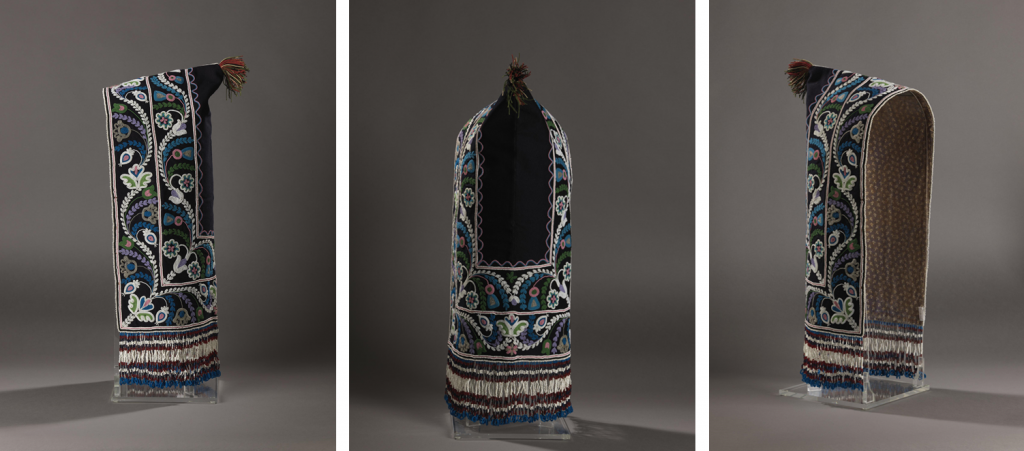by Sheila Wheesk

Beaded hood
Maker: James Bay Cree
Medium: Wool, cotton, silk, sinew, glass beads
Geography: Hudson Bay Lowlands, Ontario
Date: c. 1850s
Dimensions: 64.5 x 29.5 cm
ROM catalogue number: 2007.41.1.3
Credit Line: This acquisition was made possible by the generous support of the Louise Hawley Stone Charitable Trust.
GKS number: 58892
The northern Cree made traditional hoods from animal hide, dyed porcupine quills, caribou hair, and sinew from the earliest of times. Cath Oberholtzer (Brown, Long, and Preston 2016) indicates the James Bay Cree women made hood masterpieces, wore them, and danced in front of their tent’s poles to honour the animal’s spirit so their husbands would have a successful hunt. In time, the Cree women transferred their clothes-making and design expertise onto imported stroud trade cloth, cotton fabrics, glass beads, yarn, and sinew or thread. In this picture of a 19th-century, modern traditional hood, one can visualize its construction (“Woman’s Hood” n.d.). The James Bay Cree women folded the woolen stroud in half and sewed along one edge. They lined it with a cotton fabric and made a tassel of yarn. The tassel at the peak of the hood represents the wearer’s soul, and the design on the hood represents the cosmos. For example, Laura Peers (Brown, Long, and Preston 2016) indicates that many other hoods incorporate three Cree worldview divisions: Earth, Sky, and Water.
The three panels of this hood are representative of her environment. Ellen Smallboy, of Moose factory, says the Cree words for beaded hood is ‘miska studen.’ There are two left and right panels and one panel along the hem. The panel along the hem meets the left and right panels diagonally at the corners. She uses glass beads and sinew to create double-curved, floral motifs such as flower buds and leaves. All flowers are bilaterally symmetrical except for the white-edged flowers, which are radially symmetrical. The artist arranged the leaves along the stems in a fern-like pattern. The stems and leaves create an illusion that the flowers are alive and moving. Contributing to the illusion of movement are the long, free-hanging fringes of blue, brown and white that end in beaded loops at the hem. First Nations have always known of the environment’s animacy, and this hood reflects this understanding.
The art this beaded hood represents showcases the artist’s skills in creating lifelike images. Still, the clothes are not only designed as a sophisticated response to protect the wearer from the elements, but they are also beautifully decorated to show the animal’s spirit that their sacrifice was not a waste of skin. These spiritual considerations for the lifeforce of the animals who gave their lives to clothe people are an ancient tradition that carries into decorating clothing made of imported, manufactured materials. Research shows that only married women wore hoods matched to garments with detachable sleeves and matching capes and leggings. More specifically, Cath Oberholtzer learned through interviews that older James Bay Cree women wore beaded hoods as practical attire (Brown, Long, and Preston 2016). The clothing also represented how well their husbands could provide Hudson Bay trading post material goods. Furthermore, the women in James Bay wore these hoods to church to express their pride and maintain their culture. Therefore, this beautifully beaded 19th-century hood not only represents an artisan’s skill but also represents how Cree women held their worldview during the religious conversion processes of the same period.
Bibliography
Brown, Jennifer S. H., John Long, and Richard J. Preston, eds. 2016. Together We Survive: Ethnographic Intuitions, Friendships, and Conversations. McGill-Queen’s Native and Northern Series 79. Montreal ; Kingston ; London ; Chicago: McGill-Queen’s University Press.
“Woman’s Hood.” n.d. Royal Ontario Museum Collections. Accessed April 27, 2021. https://collections.rom.on.ca/objects/253278/womans-hood;jsessionid=F9320CC8A82E63DA347B6460170BA8D6.
